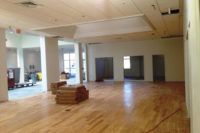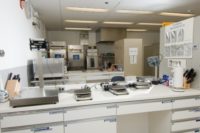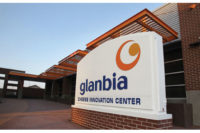New Nestlé R&D Center
New Nestlé R&D Solon reflects a new approach to comprehensive, coordinated product development

New $50 million facility supports chilled and frozen R&D activities for entrees, snacks, pizza, pasta and cookie doughs.
SOURCE: Phil Long/Associated Press Images for Nestlé

Chef Riccardo Landi

“Consumer Connect” laboratory lets experts observe how consumers use Nestlé products in real-life kitchen settings.

Oven technology laboratory features more than 60 microwave ovens from around the world. Testing is conducted at various power settings to ensure Nestlé frozen meals and snacks include optimal cooking times.


















It’s a sunny mid-July morning, about 30 minutes before an open house at Nestlé’s new Research & Development center in Solon, Ohio. There’s a buzz in the air as the first of about 100 visitors—local and state officials, architects, media and Nestlé officials—start filing in to register.
Interestingly, visitors find a silent presentation already underway in the glassed-in front lobby. A flat screen TV shows a five-minute time lapse video of the 144,000-square-foot facility under construction from September 14, 2013 to May 30, 2015. Perched atop a high pole, a panoramic camera captured every aspect of greenfield ground preparation, building and landscaping during northeast Ohio’s four seasons. It’s a fascinating, momentary story of time and place—on a small scale.
Then again, there’s even a more compelling, larger story. From a broader perspective, Nestlé’s $50 million investment comes precisely when many consumers are wary of big legacy food brands and long ingredient lists. Meanwhile, investors appear equally skeptical of “Big Food” and the CPG industry’s ability to drive profit through meaningful innovation. Unfortunately, this also comes against backdrop of dramatic mergers, downsizing and reorganization involving such well-known names as Heinz, Kraft, ConAgra, Campbell Soup and General Foods.
Last but not least, Nestlé’s dominant retail brands compete in departments (frozen) and categories (meals and entrees, pizza) that also need help. At a time when more consumers enjoy a wider array of meal options, Nielsen data show frozen prepared meal and entrée category dollar sales slipped 1.2% and frozen pizza category dollar sales inched up only 1.6% increase during a six-month tracking period ended Sept. 12, 2015. During the same period, Nestlé’s frozen pizza business (include DiGiorno, Tombstone, California Pizza Kitchen and Jack’s) grew at 2.4%, greater than the category. Stouffer’s frozen entrée sales were flat and Lean Cuisine sales were down.
Although Nestlé’s numbers improved by early November, category performance remained top of mind for Jeff Hamilton, president of Nestlé Prepared Foods, maker of Stouffer’s and Lean Cuisine.
“The reality is that during the past five years or more, what’s been available to consumers in frozen hasn’t been on-trend with how eating habits have changed,” he tells Prepared Foods. “Newer brands are addressing these changes while larger, long-established brands have not been in-step with trends and food culture. We’ve had the right intentions but our efforts did not go far enough.”
“Frozen is truly convenient and sales results aren’t a knock on a category—rather a lack of relevance of products in the category,” he adds. “Food culture is very dynamic and always changing. Trends come quickly and we have to be able to identify and address them in real time. That applies for every brand in the category. We now have R&D on site—on this campus—and right across from our marketing people. We believe this combination will translate to real-time consumer insights and product advances.”
John Carmichael is president of Nestlé Pizza, which also is home to the company’s other dough-based brands: Hot Pockets and Lean Pockets.
“As consumers’ options for convenient meals and snacks continues to increase, it is more important than ever to innovate and develop superior products that compete with those new options,” he says. “Additionally the way people eat is evolving, causing consumers to want new things from brands—even in historically indulgent categories. These include new health benefits like gluten-free and cleaner labels, as well as new flavor experiences and format options. Providing the best products that deliver on this is critical for Nestlé’s future success.”
State of the Art
Nestlé officials were planning for that future success some five to seven years ago. Already a frozen category leader, Nestlé nearly doubled its business with the 2010 purchase of Kraft’s frozen pizza brands. That deal only propelled global parent Nestlé SA and its global technical group, Nestec Ltd., to start discussing a dedicated chilled and frozen product technology center.
Those conversations led to the construction of Nestlé R&D Solon, now home to 120 chefs, consumer researchers, packaging specialists, designers, engineers and food scientists. The ultra-modern, three-story glass building not only features traditional R&D labs but also areas committed to grain science, package design and testing and a microwave technology center. There also are several pilot plant rooms committed to entrees, pizza dough and sauces. To the right—just inside the front door—there are consumer insights and tasting rooms as well as a hands-on, “Consumer Connect” kitchen where guest consumers demonstrate how they actually cook at home. A circular stairway leads visitors up to a second floor, glassed-in “Culinarium” with a research chefs kitchen.
Leading Nestlé R&D Solon is Director Sean Westcott, an Australian and 24-year food veteran who began his career in 1991 in quality and R&D at Rinoldi Hancock Pty Ltd. Beginning in 2003, he joined Burns Philp as technical director for Uncle Tobys Food. He later joined Nestlé in 2006 as R&D and innovation director for Uncle Tobys and soon moved to Vevey, Switzerland, to head innovation acceleration. He next served as global R&D manager before moving to Solon in 2013.
“Nestlé is a long-term company committed to the strategy and science behind these categories, he notes. “Our decision to invest came before the turbulence we all experienced in the frozen food market but we stayed the course and started recruiting R&D and technical resource personnel.”
He continues, “As Jeff [Hamilton] came in and we looked at how consumer eating has shifted in the US, we renewed and redefined our efforts around the ‘new health’ and looked at how we gather US market insights. R&D has to understand what consumers want and need. At the same time, our technical developers need to understand outcomes, or the relevance of what they’re doing. I’m proud to say that we’ve filed more new patents during the past year than in the last five years—and these are exciting new developments. We’re putting a stake in the ground and turning a corner—at least internally. We think these changes will be the foundation for what the business could be in the next five years.”
Among the featured speaker at Nestlé R&D Solon’s open house was Johannes Baensch, head of Global Product & Technology Development, Nestec Ltd.
“Few areas of research are as complex as food research,” he said. “Nestlé has a long-standing reputation for excellence in research on food and nutrition and our research center is regarded as one of the world’s leading laboratories in food. By creating Nestlé R&D Solon, we are transporting a significant piece of our global research expertise to the United States, our largest global market.”
Leading that market is Paul Grimwood, chairman and CEO of Nestlé USA. He also addressed open house attendees.
“We’re experiencing one of the most profound shifts in how people eat right now. To address the ever-changing landscape, we’re striving to make our products healthier and tastier using unmatched R&D capability, nutrition science and passion for quality in everything we do,” he said. “I’m pleased that Nestlé R&D Solon will enable us to better anticipate and provide consumers with the food choices they deserve and the quality they have come to expect from Nestlé.”
Fast Forward
Among those looking to improve every aspect of the business is Hamilton, who spent most of his 25-year Nestlé career in pet food before joining Nestlé Prepared Foods in March 2014. Hamilton says his team’s first job was to quickly redirect Lean Cuisine away from the brand’s “diet” roots and embrace consumers’ new definition of wellness with creative new on-trend ingredients. Meanwhile, Nestlé has refocused the Stouffer’s line and messaging around wholesome, healthy, quality ingredients.
Speaking first of Lean Cuisine, Hamilton notes, “There’s steadily increasing interest in health but the way consumers are thinking about it has really changed. It used to only be about lower fat or lower calories. Now what defines ‘healthy’ involves a whole list of new benefits: organic, high protein, non-GMO. Moreover, every consumer has their own sense of how they like to eat healthy.”
Last July saw Lean Cuisine recast its entire line and introduce 10 new Marketplace entrees that combine chef-inspired recipes, premium ingredients and on-trend health notes (non-GMO, organic, high protein, etc.). Stouffer’s drive has been to attack the image of “processed food.” The brand promotes its use of real ingredients—such as cheese and beef and pasta—while it eliminates artificial colors, artificial flavors and preservatives. Stouffer’s officials also launched an entirely new line, Fit Kitchen, last June.
“Although Fit Kitchen recipes may be a little less adventurous than those from Lean Cuisine, the effort focuses on high quality ingredients, bolder flavors and high protein (25g to 27g),” Hamilton says. “These are healthy, hearty meals with reasonable calories levels. We’re reaching out to a group of underserviced consumers—men—who have very few options that resonate with the way they want to eat.”
For his part, Hamilton already sings the praises of Nestlé R&D Solon.
“Most importantly, it has us all thinking together. It allows us to improve our speed to market, show product ideas to consumers and then move much more quickly through benchtop labs and scale-up in the pilot plant—all within one building. We can go from insight to activation in an accelerated time frame.”
He notes that 16 SKUs and two new lines—Lean Cuisine Marketplace and Stouffer’s Fit Kitchen—were ready to launch within a year of his arrival. He says both new lines are gaining sales and that Lean Cuisine’s overall sales numbers are back in the black.
“Nestlé’s investment in this global product technology center demonstrates that this is a category we believe in,” says Hamilton. “It can be a growth business again for our retail customers and very exciting for consumers. We are very committed to the future of frozen.”
Carmichael is equally enthusiastic about Nestlé R&D Solon’s state-of-the art culinary resources combined with grain science and dough technology research. He notes that new DiGiorno Pizzeria! (one of IRI’s 2014 Pacesetter sales award winners) has been successful because it delivers artisanal ingredients with a dual-textured crust that is both chewy and crispy.
Last March saw Nestlé extend DiGiorno Pizzeria! into a thin crust, a growing segment within the pizza category. Carmichael adds that Nestlé quietly reformulated its flagship DiGiorno product to eliminate artificial ingredients but retain the same rising crust performance and taste. Dough formulation and processing research also has extended California Pizza Kitchen (CPK) into new gluten-free and hand-tossed varieties.
Last but not least, Carmichael says that Nestlé also takes a “flavor forward” stance. For example, new CPK flavors and ingredients include real chorizo, Kalamata olives, artichokes and fire-roasted poblano peppers. Likewise, Tombstone has launched two Limited Edition varieties—a Bratwurst and a Diablo—that invite consumers to participate in a fun, new flavor adventure.
“For the Nestlé pizza and snacking brands to thrive, renovating current products is critical to show consumers we’re the leader in health and taste trends,” Carmichael concludes. “It’s also critical to innovate and develop products with new formats that enable our consumers to enjoy our products in new and different ways. This will require speed and focus. We have several pizza and snacking brands, and each has a unique job to do in bringing this to life.”
AT A GLANCE
Nestlé Research & Development Solon
Company: Nestlé SA / Nestlé USA
Director: Sean Westcott
Location: Solon, Ohio
Profile: Nestlé R&D Solon is dedicated to global chilled and frozen product and process development. It shares information with Nestlé businesses worldwide, including factories in Germany, France and Italy.
Investment: $50 million
Size: 144,000 sq. ft.
Personnel: Approximately 120 including chefs, consumer researchers, packaging specialists, designers, engineers and food scientists
In-House Technology Centers: Grain science, sauces, manufacturing, microwave, packaging
Brands: R&D Solon supports frozen entrees (Stouffer’s, Lean Cuisine, Lean Pockets, Hot Pockets), refrigerated pasta (Buitoni), refrigerated cookie dough (Nestlé Toll House), and frozen pizzas (DiGiorno, Tombstone, California Pizza Kitchen, Jack’s). It also supports European brands such as Wagner and Herta.
Looking for a reprint of this article?
From high-res PDFs to custom plaques, order your copy today!

















